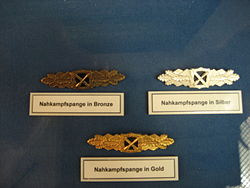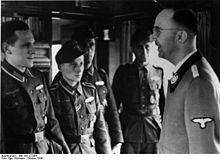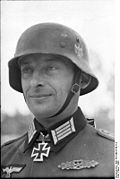- Close Combat Clasp
-
Close Combat Clasp 
Close Combat Clasp in GoldAwarded by Nazi Germany Type Clasp Eligibility Military personnel Campaign World War II Status Obsolete Statistics Established 25 November 1942 
These are the design permitted to be worn in Germany after 1957, the eagle and swastika symbol having been removed.The Close Combat Clasp (German: Nahkampfspange) is a German military award instituted on 25 November 1942 for achievement in hand to hand fighting in close quarters. The Close Combat Clasp was worn above the upper left uniform pocket. The clasp was die-cast and made of either tombac or later zinc, with a slightly curved and hand centerpiece consisting of the national emblem surmounting a crossed bayonet and hand grenade.
The award was bestowed in three classes.
- For 15 battles of close combat a Bronze Class was awarded.
- For 25 battles of close combat a Silver Class was awarded.
- For 50+ battles of close combat a Gold Class was awarded.
On order to receive this distinguished decoration, all battles and their dates had to be officially documented by the battle commander, verified by the general in charge and authenticated by several divisions of the war department. It was possible that more than one close combat battle per day was fought and therefore recorded as a separate entity.
 Heinrich Himmler presenting the Close Combat Clasp in Gold to Unteroffizier Heinz Rudolph, Unteroffizier Kray, Unteroffizier Adam Schaub und Obergefreiter Georg Felsner (left to right)
Heinrich Himmler presenting the Close Combat Clasp in Gold to Unteroffizier Heinz Rudolph, Unteroffizier Kray, Unteroffizier Adam Schaub und Obergefreiter Georg Felsner (left to right)
An exemption was made if the soldier was wounded in battle so badly that his injuries precluded a return to the front. In such a case, the criteria were reduced to 10, 20 and 40 battles. The highest number of battles in combat recorded is listed at 84 by SS-Hauptscharführer Hermann Maringgele[1]
The Gold Close Combat Clasp was often regarded in higher esteem than the Knight's Cross of the Iron Cross by the German infantry. Of the roughly 18 – 20 Million soldiers of the German Wehrmacht and Waffen-SS 36,400 received the Bronze Class, 9,500 the Silver Class and 631 the Gold Class.[2]
In 1944 a version for the German Air Force was created to note the increasing number of Air Force Personal and Paratroopers taking part in direct combat. [3]
Design
The decoration was designed by the military artist Wilhelm Ernst Peekhaus. Normally on the reverse left side of all CCC you will find the "FEC" meaning from the Latin "Fecit" (made by) followed by "W.E. Peekhaus" (the artist name) and Berlin. On the right side the manufacturer's logo or name. The badge was die-cast and made of only Zinc, depending on the manufacturer the clasp is straight or slightly curved. The design shows a central motif consisting of the national emblem surmounting a crossed bayonet and hand grenade. The centerpiece was cut out and backed with a thin, flat square steel, crimped in place on the reverse. The badge was lacquered with a composition called "Brennlack," which was a powdered metal. When oven heated the paint was burned, leaving a metallic type coating that will flake off with time. The pins are normally wider in the center, tapering at the ends. The length of the CCC varies between 95 to 97mm. The weight could be anything between 24 and 37gms depending on the metal used.[4]
References
- Thomas M. Durante (2007), The German Close Combat Clasp of World War II, ISBN 978-90-81230-11-7
- Florian Berger (2004), Ritterkreuzträger mit Nahkampfspange in Gold, ISBN 3-9501307-3-X
- Manfred Dörr, Die Träger der Nahkampfspange in Gold, Heer-Luftwaffe-Waffen-SS 1943 - 1945 ISBN 3-7648-2585-5
Categories:- Orders, decorations, and medals of Nazi Germany
- Military awards and decorations of Germany (Wehrmacht)
Wikimedia Foundation. 2010.

